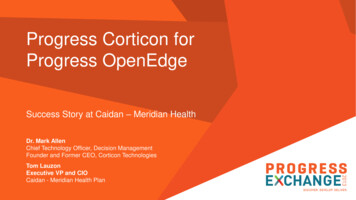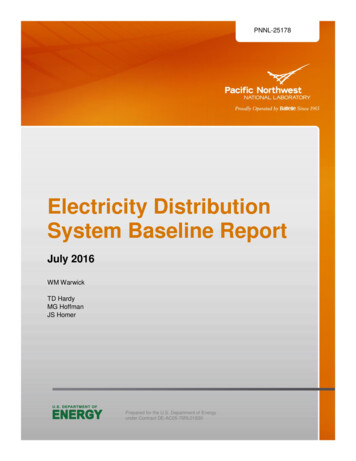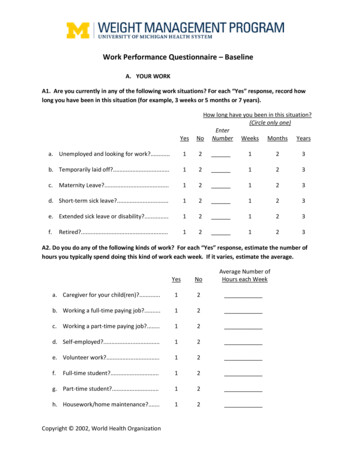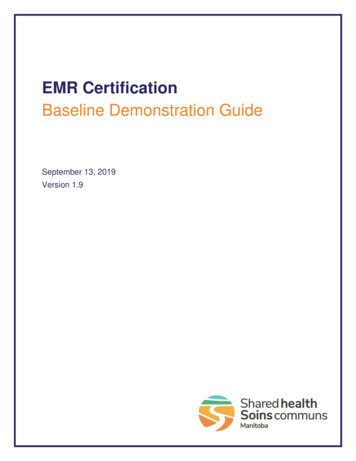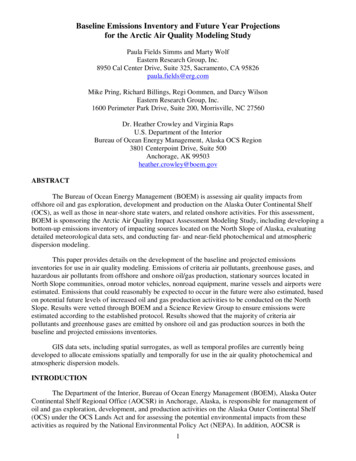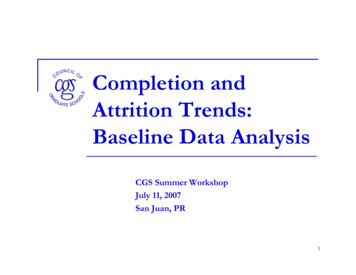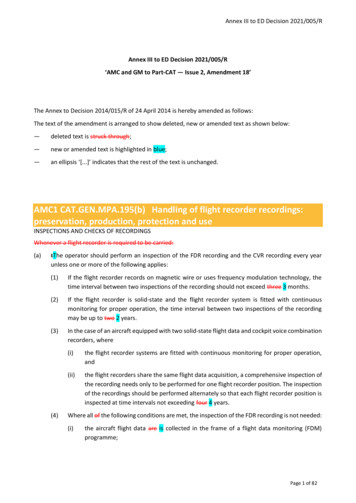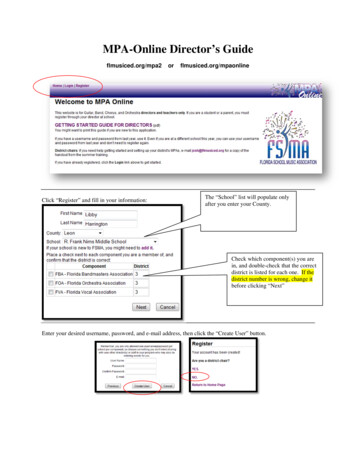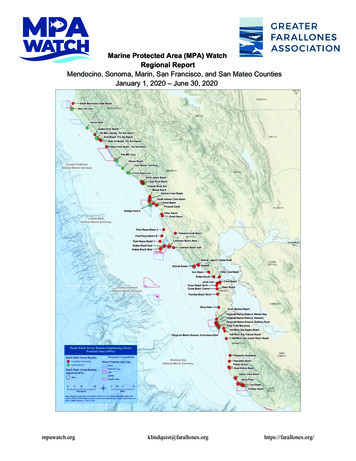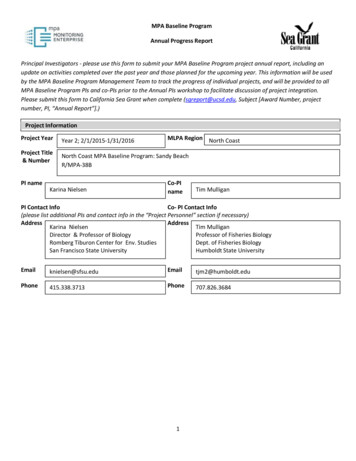
Transcription
MPA Baseline ProgramAnnual Progress ReportPrincipal Investigators - please use this form to submit your MPA Baseline Program project annual report, including anupdate on activities completed over the past year and those planned for the upcoming year. This information will be usedby the MPA Baseline Program Management Team to track the progress of individual projects, and will be provided to allMPA Baseline Program PIs and co-PIs prior to the Annual PIs workshop to facilitate discussion of project integration.Please submit this form to California Sea Grant when complete (sgreport@ucsd.edu, Subject [Award Number, projectnumber, PI, “Annual Report”].)Project InformationProject YearProject Title& NumberYear 2; 2/1/2015-1/31/2016MLPA Region North CoastNorth Coast MPA Baseline Program: Sandy BeachR/MPA-38BPI nameKarina NielsenCo-PInameTim MulliganPI Contact InfoCo- PI Contact Info(please list additional PIs and contact info in the “Project Personnel” section if necessary)AddressAddressKarina NielsenTim MulliganDirector & Professor of BiologyProfessor of Fisheries BiologyRomberg Tiburon Center for Env. StudiesDept. of Fisheries BiologySan Francisco State UniversityHumboldt State .eduPhone415.338.3713Phone707.826.36841
MPA Baseline Program Annual ReportProject Goals & ObjectivesThe overarching goal of this project is to provide a comprehensive, regional characterization of sandy beach and surf zoneecosystems in northern California. Our specific project objectives include: Produce a quantitative baseline characterization of ecologically and culturally important surf zone fishes:surfperch (especially redtail surfperch) and night smelt including data on their abundance, size structure, sexratios, feeding habits and movement patterns. Conduct targeted sampling of sand crabs, Emerita analoga, in conjunction with surfperch sampling to assessspatial and temporal correlations and investigate trophic connectivity. Engage local fishing communities in the MPA baseline survey, thus providing a foundation for long-termmonitoring of North Coast MPAs using collaborative fisheries research techniques and fostering communitysupport for MPA related management. Continue to develop and strengthen collaborative working relationships among fishermen, academicresearchers, and state agencies (via mutual data collection, workshops, reports, publications) in order toconduct effective fisheries research and management along the North Coast. Complete a comprehensive baseline description of the ecology of MPA and non-MPA sandy beachecosystems on the North Coast of California. The ecological description includes a one-timemacroinvertebrate study of abundance and diversity, monthly surveys of macrophyte wrack, birds,people and physical conditions on the beaches from September 2014 through June 2016.2
MPA Baseline Program Annual ReportSummary of Project Activities Completed to DateOverview of Project YearActivities, including progress towards meeting goals & objectivesFebruary-April 2015: Preparation for field work- Took inventory and purchased necessary gear- Prepared and organized gearMay-August 2015: Monthly hook and line sampling for surfperch and dip net hauls for night fish at 4 MPAs and associatedreference sites- Data entered into Microsoft Excel as collected- Gut content analyses conducted on redtail surfperch- Monthly sampling at South Samoa Beach, an additional reference site for Samoa SMCA, serving as data for anM.S. thesis for Ms. Michelle Succow- Conducted targeted sampling of sand crabs to assess spatial and temporal connectivity to redtail surfperchpopulationsSeptember-January 2016: Continued sampling, data analysis- Continued sampling at Samoa SMCA and 2 associated reference sites to examine redtail surfperch and sandcrab trophic links. This data will serve as a M.S. thesis for Ms. Michelle Succow- Summarized catch data in tables and figures- Continued gut content analyses on redtail surfperch- Begin to examine subsamples of night smelt for sex, length, and weightFebruary 2015 – January 2016- Continued beach surveys- Completed sorting, ID and quantification of macroinvertebrates- Initiated sand sample processing- Entered all data, created summary figuresProgress towards Education and Collaboration goals:- Strengthened working relationships with CDFW, members of the Tolowa Dee-Ni’ Nation, local communitymembers, and members of the California Commercial Beach Fisherman’s Association- Attended and presented project methods and initial results at The Western Society of Naturalists annualmeeting and the North Coast Collaborative Forum- Involved 20 different volunteer anglers and sand crab collectors consisting of Humboldt State students- Involved graduate students from Sonoma State and San Francisco State in beach surveys ad sample processing.During Year II, a total of 566 (compared to 305 during year I) redtail surfperch were sampled from MPA and pairedreference sites. Catches ranged from a high of 53 at Mad River Beach reference site, to a low of 0, at both the Ten MileSMCA/SMR and its paired Ten Mile Beach reference site. Average surfperch size ranged from a high of 271 mm (TL) atthe South Samoa Beach reference site to a low of 228 mm (TL) at the Ten Mile SMCA/SMR site.For night smelt, a total of 3 sampling trips each to 4 MPAs and associated reference. Spawning aggregationsof night smelt were observed on Kellogg Beach, Reading Rock SMCA, Samoa SMCA, and Gold Bluff Beach during 6of the 27 total sampling trips. Walker Scale values ranged between 0 and 3, with level 3 spawning eventsdocumented in Samoa SMCA and on Gold Bluff Beach. Subsamples of 100 night smelt collected during eachsampling trip were processed at the Humboldt State Marine Laboratory. The total length of night smelt wasmeasured to the nearest millimeter and gonads were examined for sex determination.3
MPA Baseline Program Annual ReportHighlights from project progress so far, such as successes achieved, new collaborations or partnerships, or interestingstories from the past year that may be suitable for a blog post or other media venue Beach driving permits were obtained from the Redwood National and State Parks for sampling at the ReadingRock SMCA and Gold Bluffs Beach sites, improving our beach access and sampling success for surfperch andsmeltCollaboration with the Tolowa Dee-Ni Nation permitted extra sampling in September at the Pyramid PointSMCA and Kellogg Beach sites.Preliminary gut analyses indicate that surfperch may be opportunistic foragers; in areas where rocky outcropsare common (i.e. Pyramid Point SMCA and Kellogg Beach) they appear to feed preferentially on barnacles,while over strictly sandy beaches (i.e. Samoa SMCA and Mad River Beach) they appear to feed predominantlyon sand crabs and other epifauna.Graduate student Ms. Michelle Succow and PI Nielsen presented preliminary results from the project at theWestern Society Naturalists Conference in Sacramento and graduate student Ms. Michelle Succow andresearch technician Megan Wood presented at the North Coast Collaborative Forum.Description of any unforeseen events and substantial challenges, and resulting effects on project activities and progress.Please indicate any issues that may affect other PI’s or require coordination with other Baseline partners (e.g., ME, DFG,Sea Grant). Unforeseen delays in obtaining beach driving permits for Reading Rock SMCA and Gold Bluffs Beach sitesextended our sampling period into July through SeptemberData status (i.e., paper/raw format or digitized; if digitized, what format?) All field collection data for surfperch have been entered into excel spreadsheets and summarized in tables All field data for wrack, birds and people and macroinvertebrate sample data have been entered into excelspreadsheets and summarized in tables and figuresSurfperch gut content data is currently being collected/processed and has begun to be transformed into excelspreadsheet formatSampling dates, locations, relative abundance data (walker scale), individual fish lengths and sex determinationfor night smelt have been entered into excel spreadsheets. 4
MPA Baseline Program Annual ReportActivities Planned for following Project Year (if applicable) – Please describe remaining work and approximatetimelines for completing that work, including any anticipated budget variances necessary to complete the project. Continued sampling until April 2016 at Samoa SMCA and its adjoining reference sites for Ms. Michelle Succow’sM.S. thesis examining redtail surfperch and sand crab trophic links.Surfperch gut contents will be identified to the lowest possible taxon by Dr. Helen Mulligan, HSU. Specialattention will be given to sand crabs (Emerita analoga), another focal taxon in this study. Basic calculations willbe used to compute an Index of Relative Importance (IRI) for each food class for each size/seasonal grouping offish. Data will be processed/analyzed February – August 2016.Further processing and analysis of night smelt data is expected to continue until May 2016.Further processing and analysis of sandy beach physical samplesData analysis and synthesis in preparation for final reportPresentation of methods and results at collaborative forums and scientific meetingsPreparation of graduate thesis, manuscripts, and final reportUpload data into Ocean Spaces data archive5
MPA Baseline Program Annual ReportProject Personnel – Please indicate additional project personnel involved in your MPA baseline project, includingstudents and volunteers, or additional PI contact information if necessary, as well as the nature of their assistance inthe project project.Students SupportedStudent VolunteersNature of AssistanceK-12Undergraduate315Beach sampling, surveys andsample sorting,identification andquantification.Masters23Supported: Beach Sampling,scheduling and logistics,preparation of reports,input & analysis of dataVolunteers: Beach samplingPhDNumber of other Volunteers not counted above and the nature of their assistance in the project: 6 volunteers from the community and the California Commercial Beach Fisherman’s Association participated in theproject as volunteer anglersAdditional PI contact info not listed on first page:Jenifer Dugan, Marine Science Institute, University of California, Santa Barbara, CA 93106-6150;j dugan@lifesci.ucsb.edu; 805-893-2675David Hubbard, Marine Science Institute, University of California, Santa Barbara, CA 93106-6150;david.hubbard@lifesci.ucsb.edu;Rosa Laucci, Tolowa Di-Nee’ Nation, 140 Rowdy Creek Road, Smith River, CA 95567; rosa.laucci@tolowa.com;707-951-3712Sean Craig, Humboldt State University, Department of Biological Sciences, 1 Harpst St., Arcata, CA 95521;sfc4@humboldt.edu; (707) 826-324566
MPA Baseline Program Annual ReportCooperating Organizations and Individuals - Please list organizations or individuals (e.g., federal or state agencies,fishermen, etc.) that provided financial, technical or other assistance to your project since its inception, including adescription of the nature of their assistance.Name of Organization or IndividualSector (City, County, Fed,private, etc.)Nature of cooperation (If financial, provide dollaramount.)California Commercial BeachFisherman’s AssociationCalifornia Department of Fish andWildlifeCommercial FishingHT Harvey and AssociatesPrivateLead field sampling in 2014 and participated infield sampling in 2015Laboratory sample processing, Data analysis andstorage (2014 size distribution and sex ratio data),Field sampling assistanceLaboratory sample processing, Data analysis andstorage (2014 size distribution and sex ratio data),Field samplingCA StateProject Outputs and Materials: Please provide any other project-relevant information, such as descriptions ofattached materials, media coverage your project has received, presentations, publications, images etc. Talks presented at the Western Society of Naturalists meeting in Sacramento, CA. November 2015: Got crabs? Predation by redtail surfperch, Amphistichus rhodoterus, on pacific sand crabs, Emerita analoga.Talk presented by Michele Succow Connecting communities, building capacity and creating ecosystem resilience through MPA monitoring inNorthern California. Talk presented by Karina Nielsen Challenges and opportunities for citizen science monitoring of mpas in california: case studies andrecommendations. Talk presented by Ryan Meyer (Nielsen et al. as co-authors)Collaborative Research on the Spawning Population of Night Smelt (Spirinchus starksi) in Humboldt and DelNorte Counties, California. Final Report submitted to Collaborative Fisheries Research West , April 2015 Table 1 (attached): Counts of Redtail surfperch species at MPAs and reference sites during year 2 samplingseason (April-December, 2015). Sampling after August 2015 is to collect data for Ms. Michelle Succow’s M.S.thesis. Poor weather conditions in October and December restricted sampling. Fish collected via hook and linesampling.Table 2 (attached): Mean total lengths (mm) of surfperch species at MPAs and reference sites during year 2sampling season (April-December, 2015). Sampling after August 2015 is to collect data for Ms. MichelleSuccow’s M.S. thesis. Poor weather conditions in October and December restricted sampling. Fish collectedvia hook and line sampling.Table 3 (attached): Relative abundance of spawning night smelt at MPAs and associated reference sites duringyear 2 sampling season (May - August, 2015). Relative abundance determined using a modified Walker Scale.Table 4 (attached): Length characteristics of spawning male night smelt at MPAs and associated referencesites during year 2 sampling season (May - August, 2015).Table 5 (attached): Length characteristics of spawning female night smelt at MPAs and associated referencesites during year 2 sampling season (May - August, 2015).8
Table 1: Counts of Redtail surfperch species at MPAs and reference sites during year 2 sampling season(April-December, 2015). Sampling after August 2015 is to collect data for Ms. Michelle Succow’s M.S.thesis. Poor weather conditions in October and December restricted sampling. Fish collected via hookand line sampling.SitePyramid PointKellogg BeachGold Bluffs BeachReading Rock SMCAMad River BeachSamoa SMCASouth Samoa BeachTen Mile SMCA/SMRTen Mile BeachTotal Monthly 00000Total Site Catch6751626914161562532564Table 2: Mean total lengths (mm) of surfperch species at MPAs and reference sites reference duringyear 2 sampling season (April-December, 2015). Sampling after August 2015 is to collect data for Ms.Michelle Succow’s M.S. thesis. Poor weather conditions in October and December restricted sampling.Fish collected via hook and line sampling.SitePyramid PointKellogg BeachGold Bluffs BeachReading Rock SMCAMad River BeachSamoa SMCASouth Samoa BeachTen Mile SMCA/SMRTen Mile BeachTotal Total Oct232-Nov---264232-278297233269Dec-Mean Total Length254254262265247265271254228256
Table 3: Relative abundance of spawning night smelt at MPAs and associated reference sitesduring year 2 sampling season (May - August, 2015). Relative abundance determined using amodified Walker Scale.SiteMayJuneJulyAugust000Pyramid Point00Kellogg Beach2Gold Bluffs Beach32Reading Rock SMCA10Mad River Beach00Samoa SMCA03Ten Mile SMCA/SMR000Ten Mile Beach000-Table 4: Length characteristics of spawning male night smelt at MPAs and associatedreference sites during year 2 sampling season (May - August, 2015).Min Length (mm) Max Length (mm) Mean Length (mm) Sample Size (n)SitePyramid Point11895Kellogg Beach107133110138Gold Bluffs Beach122265130Reading Rock SMCA10811996Mad River Beach88Samoa SMCA108125117Ten Mile SMCA/SMRTen Mile Beach----Table 5: Length characteristics of spawning female night smelt at MPAs and associatedreference sites during year 2 sampling season (May - August, 2015).Min Length (mm) Max Length (mm) Mean Length (mm) Sample Size (n)SitePyramid Point1015Kellogg Beach96105101128Gold Bluffs Beach11435110Reading Rock SMCA1041074Mad River Beach12Samoa SMCA102120106Ten Mile SMCA/SMRTen Mile Beach----
MPA Baseline Program Annual Report 5 Activities Planned for following Project Year (if applicable) – Please describe remaining work and approximate timelines for completing that work, including any antici
